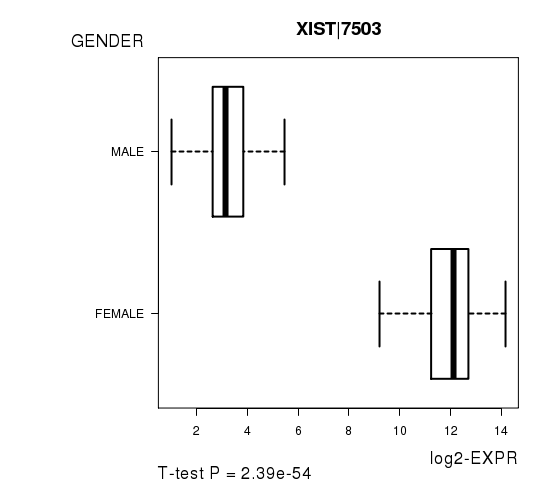(primary solid tumor cohort)
This pipeline uses various statistical tests to identify mRNAs whose expression levels correlated to selected clinical features.
Testing the association between 18190 genes and 5 clinical features across 152 samples, statistically thresholded by Q value < 0.05, 2 clinical features related to at least one genes.
-
27 genes correlated to 'GENDER'.
-
XIST|7503 , RPS4Y1|6192 , DDX3Y|8653 , KDM5D|8284 , USP9Y|8287 , ...
-
1 gene correlated to 'RADIATIONS.RADIATION.REGIMENINDICATION'.
-
ZBTB33|10009
-
No genes correlated to 'Time to Death', 'AGE', and 'KARNOFSKY.PERFORMANCE.SCORE'.
Complete statistical result table is provided in Supplement Table 1
Table 1. Get Full Table This table shows the clinical features, statistical methods used, and the number of genes that are significantly associated with each clinical feature at Q value < 0.05.
| Clinical feature | Statistical test | Significant genes | Associated with | Associated with | ||
|---|---|---|---|---|---|---|
| Time to Death | Cox regression test | N=0 | ||||
| AGE | Spearman correlation test | N=0 | ||||
| GENDER | t test | N=27 | male | N=15 | female | N=12 |
| KARNOFSKY PERFORMANCE SCORE | Spearman correlation test | N=0 | ||||
| RADIATIONS RADIATION REGIMENINDICATION | t test | N=1 | yes | N=0 | no | N=1 |
Table S1. Basic characteristics of clinical feature: 'Time to Death'
| Time to Death | Duration (Months) | 0.2-54 (median=8.7) |
| censored | N = 53 | |
| death | N = 99 | |
| Significant markers | N = 0 |
Table S2. Basic characteristics of clinical feature: 'AGE'
| AGE | Mean (SD) | 60.09 (13) |
| Significant markers | N = 0 |
Table S3. Basic characteristics of clinical feature: 'GENDER'
| GENDER | Labels | N |
| FEMALE | 54 | |
| MALE | 98 | |
| Significant markers | N = 27 | |
| Higher in MALE | 15 | |
| Higher in FEMALE | 12 |
Table S4. Get Full Table List of top 10 genes differentially expressed by 'GENDER'
| T(pos if higher in 'MALE') | ttestP | Q | AUC | |
|---|---|---|---|---|
| XIST|7503 | -37.31 | 2.389e-54 | 4.34e-50 | 1 |
| RPS4Y1|6192 | 48.24 | 2.441e-54 | 4.44e-50 | 1 |
| DDX3Y|8653 | 49.54 | 3.219e-49 | 5.85e-45 | 1 |
| KDM5D|8284 | 44.37 | 1.096e-48 | 1.99e-44 | 1 |
| USP9Y|8287 | 49.48 | 2.069e-47 | 3.76e-43 | 1 |
| CYORF15A|246126 | 42.68 | 6.12e-44 | 1.11e-39 | 1 |
| ZFY|7544 | 49.63 | 9.035e-42 | 1.64e-37 | 1 |
| EIF1AY|9086 | 42.09 | 2.671e-41 | 4.85e-37 | 1 |
| TSIX|9383 | -22.15 | 3.036e-41 | 5.52e-37 | 0.9974 |
| PRKY|5616 | 25.73 | 2.98e-35 | 5.42e-31 | 0.9989 |
Figure S1. Get High-res Image As an example, this figure shows the association of XIST|7503 to 'GENDER'. P value = 2.39e-54 with T-test analysis.

No gene related to 'KARNOFSKY.PERFORMANCE.SCORE'.
Table S5. Basic characteristics of clinical feature: 'KARNOFSKY.PERFORMANCE.SCORE'
| KARNOFSKY.PERFORMANCE.SCORE | Mean (SD) | 75.61 (14) |
| Significant markers | N = 0 |
One gene related to 'RADIATIONS.RADIATION.REGIMENINDICATION'.
Table S6. Basic characteristics of clinical feature: 'RADIATIONS.RADIATION.REGIMENINDICATION'
| RADIATIONS.RADIATION.REGIMENINDICATION | Labels | N |
| NO | 97 | |
| YES | 55 | |
| Significant markers | N = 1 | |
| Higher in YES | 0 | |
| Higher in NO | 1 |
Table S7. Get Full Table List of one gene differentially expressed by 'RADIATIONS.RADIATION.REGIMENINDICATION'
| T(pos if higher in 'YES') | ttestP | Q | AUC | |
|---|---|---|---|---|
| ZBTB33|10009 | -5.27 | 6.447e-07 | 0.0117 | 0.7327 |
Figure S2. Get High-res Image As an example, this figure shows the association of ZBTB33|10009 to 'RADIATIONS.RADIATION.REGIMENINDICATION'. P value = 6.45e-07 with T-test analysis.

-
Expresson data file = GBM-TP.uncv2.mRNAseq_RSEM_normalized_log2.txt
-
Clinical data file = GBM-TP.clin.merged.picked.txt
-
Number of patients = 152
-
Number of genes = 18190
-
Number of clinical features = 5
For survival clinical features, Wald's test in univariate Cox regression analysis with proportional hazards model (Andersen and Gill 1982) was used to estimate the P values using the 'coxph' function in R. Kaplan-Meier survival curves were plot using the four quartile subgroups of patients based on expression levels
For continuous numerical clinical features, Spearman's rank correlation coefficients (Spearman 1904) and two-tailed P values were estimated using 'cor.test' function in R
For two-class clinical features, two-tailed Student's t test with unequal variance (Lehmann and Romano 2005) was applied to compare the log2-expression levels between the two clinical classes using 't.test' function in R
For multiple hypothesis correction, Q value is the False Discovery Rate (FDR) analogue of the P value (Benjamini and Hochberg 1995), defined as the minimum FDR at which the test may be called significant. We used the 'Benjamini and Hochberg' method of 'p.adjust' function in R to convert P values into Q values.
This is an experimental feature. The full results of the analysis summarized in this report can be downloaded from the TCGA Data Coordination Center.